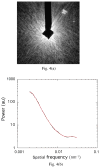An assessment of the resolution limitation due to radiation-damage in x-ray diffraction microscopy
- PMID: 20463854
- PMCID: PMC2867487
- DOI: 10.1016/j.elspec.2008.10.008
An assessment of the resolution limitation due to radiation-damage in x-ray diffraction microscopy
Abstract
X-ray diffraction microscopy (XDM) is a new form of x-ray imaging that is being practiced at several third-generation synchrotron-radiation x-ray facilities. Nine years have elapsed since the technique was first introduced and it has made rapid progress in demonstrating high-resolution three-dimensional imaging and promises few-nm resolution with much larger samples than can be imaged in the transmission electron microscope. Both life- and materials-science applications of XDM are intended, and it is expected that the principal limitation to resolution will be radiation damage for life science and the coherent power of available x-ray sources for material science. In this paper we address the question of the role of radiation damage. We use a statistical analysis based on the so-called "dose fractionation theorem" of Hegerl and Hoppe to calculate the dose needed to make an image of a single life-science sample by XDM with a given resolution. We find that for simply-shaped objects the needed dose scales with the inverse fourth power of the resolution and present experimental evidence to support this finding. To determine the maximum tolerable dose we have assembled a number of data taken from the literature plus some measurements of our own which cover ranges of resolution that are not well covered otherwise. The conclusion of this study is that, based on the natural contrast between protein and water and "Rose-criterion" image quality, one should be able to image a frozen-hydrated biological sample using XDM at a resolution of about 10 nm.
Figures







References
-
- Barty A, Marchesini S, Chapman HN, Cu C, Howells MR, Shapiro DA, Minor AM, Spence JCH, Weierstall U, Noy JI, Hau-Riege SP, Artyukhin AB, Baumann T, Willey T, Stolken J, vanBuuren T, Kinney JH. Three-Dimensional Coherent X-Ray Diffraction Imaging of a Ceramic Nanofoam: Determination of Structural Deformation Mechanisms. Phys Rev Lett. 2008;101:055501. - PubMed
-
- Baruchel J, Bleuet P, Bravin A, Coan P, Lima E, Madsen A, Ludwig W, Pernot P, Susini J. Advances in synchrotron hard X-ray based imaging. Comptes Rendus Physique. 2008;9:624–641.
-
- Beetz T, Howells MR, Jacobsen C, Kao CC, Kirz J, Lima E, Mentes TO, Miao H, Sanchez-Hanke C, Sayre D, Shapiro D. Apparatus for X-ray diffraction microscopy and tomography of cryo specimens. Nucl Instrum Meth A. 2005;545:459–468.
-
- Bergh M, Huldt G, Tîmneanu N, Maia F, Hajdu J. Feasibility of Imaging Living Cells at Sub-Nanometer Resolutions by Ultra-fast X-ray Diffraction. Quarterly Review of Biophysics. 2008 accepted. - PubMed
-
- Burmeister WP. Structural changes in a cryo-cooled protein crystal owing to radiation damage. Acta Cryst. 2000;D56:328–341. - PubMed
Grants and funding
LinkOut - more resources
Full Text Sources
Other Literature Sources
